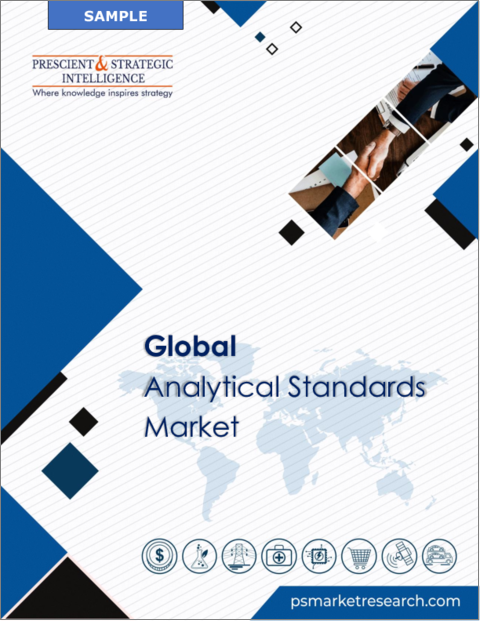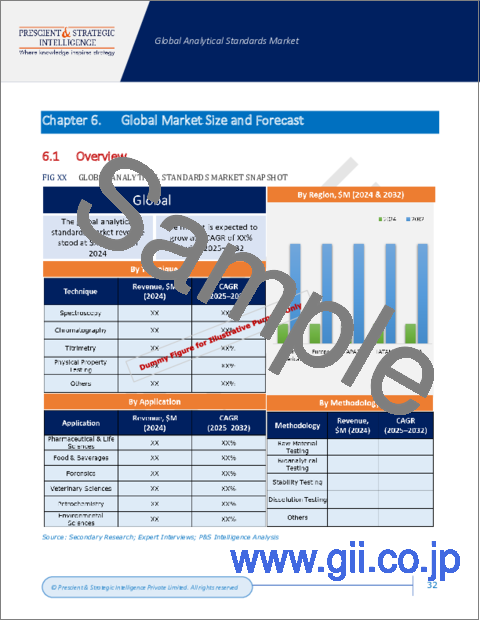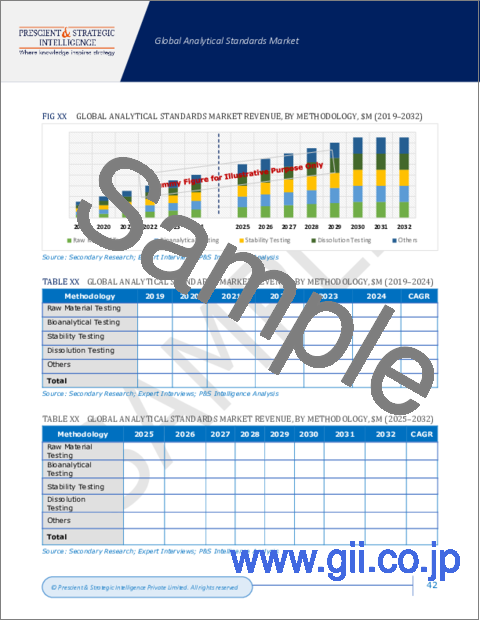|
|
市場調査レポート
商品コード
1463785
標準試薬の世界市場:市場規模・シェア分析 (技術別・用途別・手法別)、産業の需要予測 (~2030年)Analytical Standards Market Size and Share Analysis by Technique, Application, Methodology - Global Industry Demand Forecast to 2030 |
||||||
|
|||||||
| 標準試薬の世界市場:市場規模・シェア分析 (技術別・用途別・手法別)、産業の需要予測 (~2030年) |
|
出版日: 2024年03月26日
発行: Prescient & Strategic Intelligence
ページ情報: 英文 220 Pages
納期: 2~3営業日
|
全表示
- 概要
- 目次
市場概要
世界の標準試薬の市場規模は、2023年に16億1,890万米ドルとなり、2024~2030年に7.0%のCAGRで成長し、2030年には25億8,810万米ドルに達すると予測されています。調査作業の標準は、材料や化学物質がさらに使用されるために超えなければならない特定の要件です。これらは「基準化合物」であり、調査対象物の決定、未知物質の決定、品質保証試験に不可欠です。
製薬・ライフサイエンス分野では、臨床試験の増加に伴い、分析用化学物質の必要性が高まっています。このような濃縮化合物は、例えば医薬品の化学的・物理的安定性を分析するために使用されます。
さらに、バイオ医薬品セクターは、世界で最も急成長している標準試薬市場で重要な地位を占めています。標準試薬は、アッセイや各種バイオマーカーの開発から、ラボでの製造や試験、微量物質の同定や純度評価まで、幅広い用途が見出されています。
主な考察
2023年、クロマトグラフィーの業界シェアは25%であり、予測期間中に著しい発展が見られると予測されています。
北米地域は標準試薬の一大市場であり、予測期間中のCAGRは7.2%です。
同地域は、地場産業、規制当局による輸出コンプライアンス、同地域への高い研究開発投資から多くの恩恵を受けています。
当レポートでは、世界の標準試薬の市場について分析し、市場の基本構造・最新情勢や主な促進・抑制要因、世界全体および地域別・主要国の市場規模の動向見通し (金額ベース、2017~2030年)、技術別・用途別・手法別の詳細動向、現在の市場競争の状況、主要企業のプロファイルなどを調査しております。
目次
第1章 調査範囲
第2章 調査手法
第3章 エグゼクティブサマリー
第4章 市場指標
第5章 業界の展望
- 市場力学
- 動向
- 促進要因
- 抑制要因/課題
- 促進要因/抑制要因の影響分析
- 新型コロナウイルス感染症 (COVID-19) の影響
- ポーターのファイブフォース分析
第6章 世界市場
- 概要
- 市場収益:技術別 (2017~2030年)
- 市場収益:用途別 (2017~2030年)
- 市場収益:手法別 (2017~2030年)
- 市場収益:地域別 (2017~2030年)
第7章 北米市場
- 概要
- 市場収益:技術別 (2017~2030年)
- 市場収益:用途別 (2017~2030年)
- 市場収益:手法別 (2017~2030年)
- 市場収益:国別 (2017~2030年)
第8章 欧州市場
第9章 アジア太平洋市場
第10章 ラテンアメリカ市場
第11章 中東・アフリカ市場
第12章 米国市場
- 概要
- 市場収益:技術別 (2017~2030年)
- 市場収益:用途別 (2017~2030年)
- 市場収益:手法別 (2017~2030年)
第13章 カナダ市場
第14章 ドイツ市場
第15章 フランス市場
第16章 英国市場
第17章 イタリア市場
第18章 スペイン市場
第19章 日本市場
第20章 中国市場
第21章 インド市場
第22章 オーストラリア市場
第23章 韓国市場
第24章 ブラジル市場
第25章 メキシコ市場
第26章 サウジアラビア市場
第27章 南アフリカ市場
第28章 アラブ首長国連邦 (UAE) 市場
第29章 競合情勢
- 市場参入企業とその提供製品/サービスの一覧
- 主要企業の競合ベンチマーク
- 主要企業の製品ベンチマーク
- 最近の戦略展開状況
第30章 企業プロファイル
- Merck KGaA
- Agilent Technologies Inc.
- Waters Corporation
- LGC Standards Ltd.
- PerkinElmer Inc.
- SPEX CertiPrep
- AccuStandard Inc.
- Thermo Fisher Scientific Inc.
第31章 付録
Market Overview
The analytical standards market size stood at USD 1,618.9 million in 2023, and it is expected to grow at a CAGR of 7.0% during 2024-2030, to reach USD 2,588.1 million by 2030. The standards for analytical work are the specific requirements that a material or chemical must exceed to be used further. They are 'reference compounds'; and they are vital in the determination of analytes, determination of unknown substances, and quality assurance testing.
The global market is providing the opportunity to launch products with high commercial viability in pharmaceutical and biotechnology, food safety and quality assurance, environmental analysis, forensics, and many other applications.
The necessity of analytical chemicals is more felt in the pharmaceutical and life sciences sector because of the increasing number of clinical trials. Such concentrated compounds are used to analyze the chemical and physical stability, for instance, of drugs.
As a result, the growing incidence of different diseases that drive drug R&D is projected to bring about a CAGR of 7.3% in the global pharmaceutical and life sciences sector in terms of the forecast period.
Additionally, the biopharmaceutical sector holds the position of the fastest-growing analytical standards marketplace in the world. The analytical standard compounds find a wide range of applications from developing assays and various biomarkers to their production and testing in the labs and the trace material identification and purity assessment.
Key Insights
In 2023, the chromatography category had a substantial industry share of 25% and is projected to witness significant development in the projection period.
Development is propelled by augmented research and development activities in drugs and biopharmaceuticals, along with technical improvements.
Chromatography plays an important role in noticing and separating chemical constituents, monitoring ecologies, studying distant galaxies, advancing medication effectiveness, and characterizing proteins.
The category's improvement is boosted by the increasing populace affected by chronic illnesses, leading to augmented demand for medications.
The North American region is the dominating industry for analytical standards, with an anticipated CAGR of 7.2% during the projection period.
The region benefits a lot from the local industry, export compliance imposed by regulatory authorities, as well as the high R&D investment in the area.
The major makers of reference compounds in North America are the primary source of a large sale of the compounds to the pharmaceutical and chemical industries
The use of analytical technologies is growing in daily life to achieve many purposes in the lab such as environmental monitoring, drug testing, forensic use, food testing, and so on.
The U.S. and Canada, with high per capita incomes and supportive state policies, are experiencing growth in the market by giving people more access to healthcare services.
The contamination of food is a substantial worldwide health concern, leading to food-borne contagions, allergies, and intoxication.
More than 600 million individuals are affected by food-borne diseases yearly, resulting in around 420,000 demises and 33 million healthy life years lost.
Food-borne diseases cause approximately USD 95 billion in productivity loss in low- and middle-income countries, with global treatment costs reaching around USD 15 billion annually.
Table of Contents
Chapter 1. Research Scope
- 1.1. Research Objectives
- 1.2. Market Definition
- 1.3. Analysis Period
- 1.4. Market Size Breakdown by Segments
- 1.4.1. Market size breakdown, by technique
- 1.4.2. Market size breakdown, by application
- 1.4.3. Market size breakdown, by methodology
- 1.4.4. Market size breakdown, by region
- 1.4.5. Market size breakdown, by country
- 1.5. Market Data Reporting Unit
- 1.5.1. Value
- 1.6. Key Stakeholders
Chapter 2. Research Methodology
- 2.1. Secondary Research
- 2.1.1. Paid
- 2.1.2. Unpaid
- 2.1.3. P&S Intelligence database
- 2.2. Primary Research
- 2.3. Market Size Estimation
- 2.4. Data Triangulation
- 2.5. Currency Conversion Rates
- 2.6. Assumptions for the Study
- 2.7. Notes and Caveats
Chapter 3. Executive Summary
Chapter 4. Market Indicators
Chapter 5. Industry Outlook
- 5.1. Market Dynamics
- 5.1.1. Trends
- 5.1.2. Drivers
- 5.1.3. Restraints/challenges
- 5.1.4. Impact analysis of drivers/restraints
- 5.2. Impact of COVID-19
- 5.3. Porter's Five Forces Analysis
- 5.3.1. Bargaining power of buyers
- 5.3.2. Bargaining power of suppliers
- 5.3.3. Threat of new entrants
- 5.3.4. Intensity of rivalry
- 5.3.5. Threat of substitutes
Chapter 6. Global Market
- 6.1. Overview
- 6.2. Market Revenue, by Technique (2017-2030)
- 6.3. Market Revenue, by Application (2017-2030)
- 6.4. Market Revenue, by Methodology (2017-2030)
- 6.5. Market Revenue, by Region (2017-2030)
Chapter 7. North America Market
- 7.1. Overview
- 7.2. Market Revenue, by Technique (2017-2030)
- 7.3. Market Revenue, by Application (2017-2030)
- 7.4. Market Revenue, by Methodology (2017-2030)
- 7.5. Market Revenue, by Country (2017-2030)
Chapter 8. Europe Market
- 8.1. Overview
- 8.2. Market Revenue, by Technique (2017-2030)
- 8.3. Market Revenue, by Application (2017-2030)
- 8.4. Market Revenue, by Methodology (2017-2030)
- 8.5. Market Revenue, by Country (2017-2030)
Chapter 9. APAC Market
- 9.1. Overview
- 9.2. Market Revenue, by Technique (2017-2030)
- 9.3. Market Revenue, by Application (2017-2030)
- 9.4. Market Revenue, by Methodology (2017-2030)
- 9.5. Market Revenue, by Country (2017-2030)
Chapter 10. LATAM Market
- 10.1. Overview
- 10.2. Market Revenue, by Technique (2017-2030)
- 10.3. Market Revenue, by Application (2017-2030)
- 10.4. Market Revenue, by Methodology (2017-2030)
- 10.5. Market Revenue, by Country (2017-2030)
Chapter 11. MEA Market
- 11.1. Overview
- 11.2. Market Revenue, by Technique (2017-2030)
- 11.3. Market Revenue, by Application (2017-2030)
- 11.4. Market Revenue, by Methodology (2017-2030)
- 11.5. Market Revenue, by Country (2017-2030)
Chapter 12. U.S. Market
- 12.1. Overview
- 12.2. Market Revenue, by Technique (2017-2030)
- 12.3. Market Revenue, by Application (2017-2030)
- 12.4. Market Revenue, by Methodology (2017-2030)
Chapter 13. Canada Market
- 13.1. Overview
- 13.2. Market Revenue, by Technique (2017-2030)
- 13.3. Market Revenue, by Application (2017-2030)
- 13.4. Market Revenue, by Methodology (2017-2030)
Chapter 14. Germany Market
- 14.1. Overview
- 14.2. Market Revenue, by Technique (2017-2030)
- 14.3. Market Revenue, by Application (2017-2030)
- 14.4. Market Revenue, by Methodology (2017-2030)
Chapter 15. France Market
- 15.1. Overview
- 15.2. Market Revenue, by Technique (2017-2030)
- 15.3. Market Revenue, by Application (2017-2030)
- 15.4. Market Revenue, by Methodology (2017-2030)
Chapter 16. U.K. Market
- 16.1. Overview
- 16.2. Market Revenue, by Technique (2017-2030)
- 16.3. Market Revenue, by Application (2017-2030)
- 16.4. Market Revenue, by Methodology (2017-2030)
Chapter 17. Italy Market
- 17.1. Overview
- 17.2. Market Revenue, by Technique (2017-2030)
- 17.3. Market Revenue, by Application (2017-2030)
- 17.4. Market Revenue, by Methodology (2017-2030)
Chapter 18. Spain Market
- 18.1. Overview
- 18.2. Market Revenue, by Technique (2017-2030)
- 18.3. Market Revenue, by Application (2017-2030)
- 18.4. Market Revenue, by Methodology (2017-2030)
Chapter 19. Japan Market
- 19.1. Overview
- 19.2. Market Revenue, by Technique (2017-2030)
- 19.3. Market Revenue, by Application (2017-2030)
- 19.4. Market Revenue, by Methodology (2017-2030)
Chapter 20. China Market
- 20.1. Overview
- 20.2. Market Revenue, by Technique (2017-2030)
- 20.3. Market Revenue, by Application (2017-2030)
- 20.4. Market Revenue, by Methodology (2017-2030)
Chapter 21. India Market
- 21.1. Overview
- 21.2. Market Revenue, by Technique (2017-2030)
- 21.3. Market Revenue, by Application (2017-2030)
- 21.4. Market Revenue, by Methodology (2017-2030)
Chapter 22. Australia Market
- 22.1. Overview
- 22.2. Market Revenue, by Technique (2017-2030)
- 22.3. Market Revenue, by Application (2017-2030)
- 22.4. Market Revenue, by Methodology (2017-2030)
Chapter 23. South Korea Market
- 23.1. Overview
- 23.2. Market Revenue, by Technique (2017-2030)
- 23.3. Market Revenue, by Application (2017-2030)
- 23.4. Market Revenue, by Methodology (2017-2030)
Chapter 24. Brazil Market
- 24.1. Overview
- 24.2. Market Revenue, by Technique (2017-2030)
- 24.3. Market Revenue, by Application (2017-2030)
- 24.4. Market Revenue, by Methodology (2017-2030)
Chapter 25. Mexico Market
- 25.1. Overview
- 25.2. Market Revenue, by Technique (2017-2030)
- 25.3. Market Revenue, by Application (2017-2030)
- 25.4. Market Revenue, by Methodology (2017-2030)
Chapter 26. Saudi Arabia Market
- 26.1. Overview
- 26.2. Market Revenue, by Technique (2017-2030)
- 26.3. Market Revenue, by Application (2017-2030)
- 26.4. Market Revenue, by Methodology (2017-2030)
Chapter 27. South Africa Market
- 27.1. Overview
- 27.2. Market Revenue, by Technique (2017-2030)
- 27.3. Market Revenue, by Application (2017-2030)
- 27.4. Market Revenue, by Methodology (2017-2030)
Chapter 28. U.A.E. Market
- 28.1. Overview
- 28.2. Market Revenue, by Technique (2017-2030)
- 28.3. Market Revenue, by Application (2017-2030)
- 28.4. Market Revenue, by Methodology (2017-2030)
Chapter 29. Competitive Landscape
- 29.1. List of Market Players and their Offerings
- 29.2. Competitive Benchmarking of Key Players
- 29.3. Product Benchmarking of Key Players
- 29.4. Recent Strategic Developments
Chapter 30. Company Profiles
- 30.1. Merck KGaA
- 30.1.1. Business overview
- 30.1.2. Product and service offerings
- 30.1.3. Key financial summary
- 30.2. Agilent Technologies Inc.
- 30.2.1. Business overview
- 30.2.2. Product and service offerings
- 30.2.3. Key financial summary
- 30.3. Waters Corporation
- 30.3.1. Business overview
- 30.3.2. Product and service offerings
- 30.3.3. Key financial summary
- 30.4. LGC Standards Ltd.
- 30.4.1. Business overview
- 30.4.2. Product and service offerings
- 30.4.3. Key financial summary
- 30.5. PerkinElmer Inc.
- 30.5.1. Business overview
- 30.5.2. Product and service offerings
- 30.5.3. Key financial summary
- 30.6. SPEX CertiPrep
- 30.6.1. Business overview
- 30.6.2. Product and service offerings
- 30.6.3. Key financial summary
- 30.7. AccuStandard Inc.
- 30.7.1. Business overview
- 30.7.2. Product and service offerings
- 30.7.3. Key financial summary
- 30.8. Thermo Fisher Scientific Inc.
- 30.8.1. Business overview
- 30.8.2. Product and service offerings
- 30.8.3. Key financial summary
Chapter 31. Appendix
- 31.1. Abbreviations
- 31.2. Sources and References
- 31.3. Related Reports





